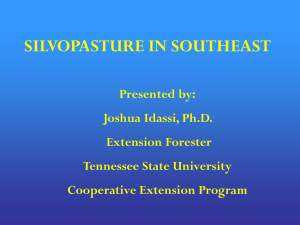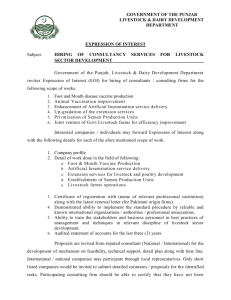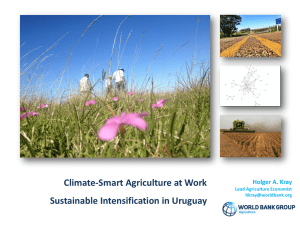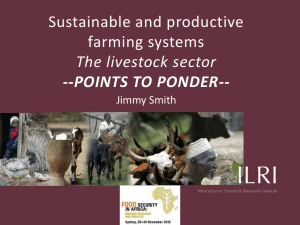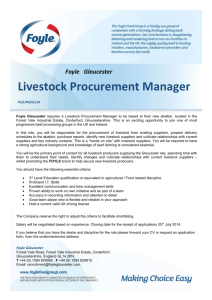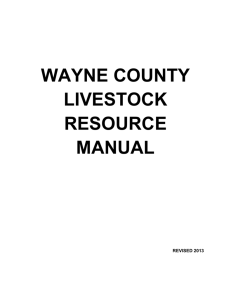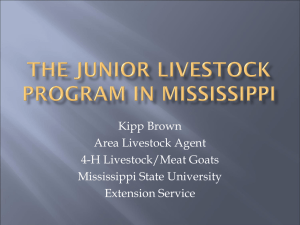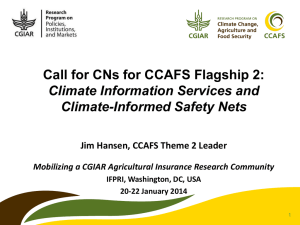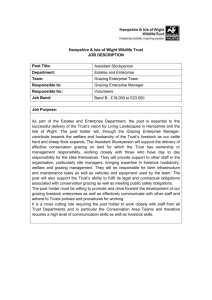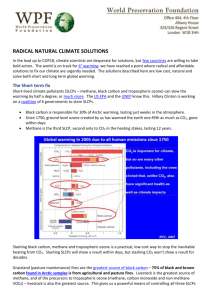AG 2012
advertisement
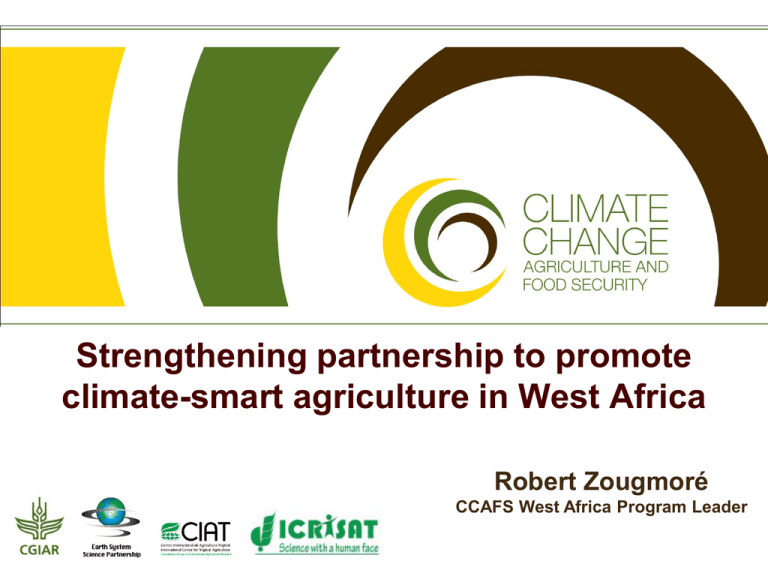
Strengthening partnership to promote climate-smart agriculture in West Africa Robert Zougmoré CCAFS West Africa Program Leader Length of growing season is likely to decline.. Length of growing period (%) To 2090, taking 14 climate models Four degree rise Thornton et al. (2010) ILRI/CCAFS >20% loss 5-20% loss No change 5-20% gain >20% gain What is Climate Smart Agriculture? Agriculture that sustainably: 1. increases productivity 2. resilience (adaptation) 3. reduces GHG (mitigation) And enhances achievement of national food security and development goals (FAO, 2010) WWW.FAO.ORG/CLIMATECHANGE/CLIMATESMART/EN Food Security Ecological foot print Adaptation “Climate smart means landscape and policy smart” CSA is not business as usual? Multiple benefits Attention to synergies and trade-offs New partnerships New types of finance It’s a multitude of trade-offs… •Across sub-sectors (e.g. residues to soils or livestock?) •Across spatial scales (e.g. more productive agriculture can result in forest clearance) •Different kinds of households (e.g. some risk insurance exclude female-headed households) •Short-term vs. long term benefits (e.g. livestock risk insurance can promote land degradation) It’s all about scale • CSA can have different meanings depending upon the scale at which it is being applied: • At local scale: opportunities for higher production, e.g. through improved management • At national scale: e.g. providing frameworks that incentivize sustainable management practices • At global scale: e.g. setting rules for global trade • For smallholders: greater food security and resilience against shocks • For intensive agriculture: opportunities to reduce emissions Effective partnership to ensure that the different temporal and spatial scales work together properly Some climate-smart agricultural practices Crop management Livestock management Intercropping Improved feeding with legumes strategies Crop rotations Rotational grazing New crop Fodder crops varieties Grassland Improved storage restoration and and processing conservation techniques Manure Greater crop treatment diversity Improved livestock health Animal husbandry improvements Soil and water management Conservation agriculture Contour planting Terraces and bunds Planting pits Water storage Alternate wetting and drying (rice) Dams, pits, ridges Improved irrigation (drip) Agroforestry Boundary trees and hedgerows Nitrogen-fixing trees on farms Multipurpose trees Improved fallow with fertilizer shrubs Woodlots Fruit orchards Integrated food energy systems Biogas Production of energy plants Improved stoves All practices presented here improve food security and lead to higher productivity, but their ability to address adaptation and mitigation varies Total annual GHG emissions 1,000 t CO2e, from land-use change, livestock, nitrogen fertilizer consumption and fires in grazing lands (Brown et al 2011) Region East Africa Ethiopia Kenya Tanzania Uganda Land-Use Change 7,339 1,812 1,833 1,112 Subtotal 12,097 74,093 722 273 1,664 440 31 369 2,778 8,779 1,865 9,270 10,405 3,364 33,683 14,874 107,776 Country West Africa Burkina Faso Ghana Mali Niger Senegal Subtotal Grand Total Livestock 41,966 11,988 13,935 6,204 Nitrogen Grazing Area Fertilizer Burned 339 1,254 323 232 42 1,736 18 524 50,897 14,356 17,546 7,858 Total from NC 32,72 12,08 28,01 5,79 3,745 90,657 78,62 18 55 64 14 84 235 306 491 241 9 249 1,297 9,377 4,076 10,015 10,460 4,066 37,993 4,50 4,63 7,03 6,23 4,51 26,91 957 5,043 128,649 105,54 Total We need mitigation options Cropland management Land cover change Grazing land management Management of organic soils Restoration of degraded lands GHG reduction Manurebiosolid management Bioenergy Livestock management Importance of trees in fields and farming landscapes Are there opportunities to reduce emissions or increase sequestration? Management option Mitigation Potential Actions required Livestock High Technical options? Soil C sequestration Moderate Incentives? Monitoring? Reduced burning Moderate Technical options? Land rehabilitation Moderate Investment Fertilizer Low Future efficiencies, sustainable intensification? Mitigation: Changes in agricultural and landscape management Agriculture Energy • Permanent plantings (trees, shrubs, grasses) • Mixed farming systemsgrasslands systems • Conservation agriculture practices • Manure management • Ruminant nutrition • • • • Solar Biogas Tillage Transport Evergreen agriculture with Faidherbia albida Engaging multiple stakeholders to facilitate enhanced climatic risk management Early action: building on proven technologies, practices and approaches • • • • • • • Agroforestry systems-Conservation agriculture Soil and nutrient management Water harvesting and use Pest and disease control Resilient ecosystems Genetic resources Harvesting, processing and supply chains On-the-ground implementation (PAR) But not only coping strategies Rehabilitation, Prevention, sustainable intensification… Integrated soil fertility and water management Naturally assisted tree regeneration in Niger New AGF parklands in Zinder (Faidherbia Albida, ≈ 1 M ha This farm family has been food secure since they began rehabilitation Increased resilience to inter-annual rainfall variability in improved fallow systems in Malawi 2,5 Yield (t ha-1) 2 1,5 1 0,5 0 1001 1017 551 962 Seasonal rainfall (mm) Sole maize Maize + sesbania 522 Institutional & policy options • • • • • • Enabling policy environment Information production and dissemination Climate data and information gaps Dissemination mechanisms Preparing institutions at the grassroots Institutions to support financing and insurance needs • Adaptation through awareness creation and empowerment • Education of future generations (curricula) The Political Dimension: African Union’s pre-Durban COP17 publication Way forwards? • Provide an enabling legal and political environment • Improve market accessibility • Involve all stakeholders in the project-planning process • Improve access to knowledge and capacity strengthening (short & long-terms) • Introduce more secure tenure • Overcome the barriers of high opportunity costs to land • Improve access to farm implements and capital • Communication efforts for widespread dissemination of information Regional and national learning platforms For information exchange, capacity strengthening, building consensus around issues and priorities National and regional agencies Research providers NGOs & policy think tanks Regional economic community Advisory services Farmer organisations CCAFS PARTICIPATORY ACTION RESEARCH PARTNERS FO/CBO Objective: Test, adapt and monitor strategic innovations supporting climate-smart agriculture Approach: particular actions, interventions tested and implemented simultaneously with local communities, partners, researchers & development workers, cooperating closely PILOT SITES IN WEST AFRICA • Kaffrine (Senegal) • Kollo (Niger) • Ségou (Mali) • Lawra-Jirapa (Ghana) • Yatenga (Tougou) NARES ARIs UNIVs CCAFS (CGIAR + ESSP) RECs (CILSS, INSAH, etc.) PRIVATE NGOs CSO


